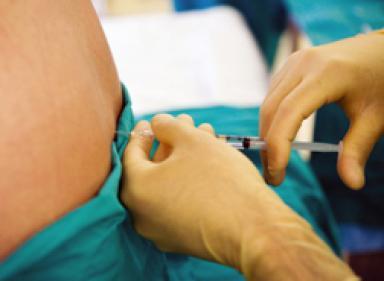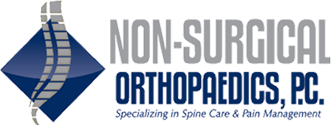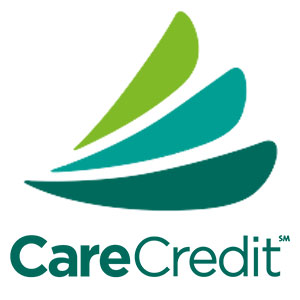Prolotherapy Injection Treatment in Marietta, GA

Prolotherapy (or Regenerative Injection Therapy) was originally used by Hippocrates over 2500 years ago to help a javelin thrower's shoulder pain. The concept was investigated, utilized, and refined by George Hackett, MD, over 70 years ago, and has been used by many other physicians since, including the former Surgeon General of the United States, C. Everett Koop, MD. The cause of a great deal of musculoskeletal pain is related to damage, laxity, or weakening of connective tissue , which normally controls joint movement and provides support for standing, sitting, and movements of the extremities.
These tissues are frequently damaged by trauma and the initial healing response may not adequately repair the structures. Anti-inflammatory medications, frequently taken after injury, also dampen the healing process and result limited connective tissue healing. The structures may also become weak because of hormones; variations and deficiencies, such as with pregnancy , hypothyroidism, menopause, or "andropause" (male hormone deficiency associated with aging). Other individuals are predisposed because of genetic variation, possibly of weaker collagen or more elastic ligaments (double-jointeed-ness) and perhaps other as yet undiscovered causes. The result of the reduced structural stability is a chronic strain of the remaining ligament and tendon fibers, which are connected to the extremely sensitive periosteum of the bone, which, through nerves, sends pain signals to the brain.
Pain can originate from any ligament, tendon, or joint in the body, and Prolotherapy can strengthen each of these types of structures, Therefore, the probability is high that a patient with pain from the joints in the neck, mid-back, or low back will respond to treatment. Other structures that respond well include the hip, knee, ankle, toe, shoulder, elbow, wrist, finger, and thumb. Pain that can be reproduced by pressure on the tendon or ligament attachment to bone can usually be improved or relieved with reconstructive injections.
Has Prolotherapy been studied and proven?
Numerous studies have been shown a success rate of over 80% over many thousands of patients, with success judged as at least 50% reduction in pain. This is quite remarkable, given that the treatment has minimal side effects and cost compared to other surgical and non-surgical treatment. It is estimated that over 2,000,000 patients have been treated with Prolotherapy over 75 years.
How is Prolotherapy administered?
Injections containing relatively harmless dextrose (sugar), local anesthetic, and other agents are placed at the attachments of ligament and tendon tissue to initiate a healing response , which results in the growth (or proliferation) of fibrous tissue. This creates a stronger bond at these attachment points, lessening the load on the individual fibers. The attachment points may also become less sensitive. Usually patients report significantly less pain, improved range of motion, and improved function,permanently. The body continues to "remodel" the bond so that even more stability occurs over the year following the treatment.
How many treatments are needed?
The injections are administered approximately 4-6 weeks apart, with an average number of 4-6 injections,. The typical time frame for a course of treatment is 4-6 months. Patients are usually sore for 3-7 days after the procedure and may begin to see benefit after the first treatment, although many patients may only begin to note significant improvement by the third or fourth treatment. Treatment for a single region of the body may take 10-15 minutes per session and may consist of only a few or of many injections sites.
After your Prolotherapy Injection
It is typical to experience soreness, aching, burning, swelling, and muscle spasms following the injection for one to four days, and occasionally longer than a week. This is because the injection is intended to produce irritation and inflammation in an effort to ultimately repair, strengthen, and heal the involved tissues. Occasionally, numbness in the area of the injection may be noted, which usually resolves in a short time period. There may be minor bruising at the injection site. The potential risk for infection is exceedingly low because of the use of careful technique, skin preparation, the solutions utilized and the nature of the induced inflammation, which is a natural infection-fighter.
Avoid using anti-inflammatory medication, such as prescription Non-Steroidal Anti-inflammatories (NSAID's), Ibuprofen, Advil, Naprosyn, Alleve, aspirin, or aspirin-containing products. Baby Aspirin may be taken if it is intended to prevent stroke or heart attack. These medications undermine your body's attempts to heal injured structures and will reduce the gains made from Prolotherapy injections.
You may use Tylonel, Hydrocodone, Ultram, Darvocet, and other pain medications, which do not contain anti-inflammatory medication.
Warm, moist heat applied using towels, baths, warm showers, or a hot (not too hot) water bottle may be helpful for muscle spasm and aches. Ice may also be used, but this tends to reduce blood flow through the tissues and may result in a slower response to the injection.
Stretching throughout the day is usually helpful. There are no activity restrictions and movement is encouraged. The stress of movement helps to produce organized, normal, strong ligaments and connective tissues. Range of motion is usually improved as the joints become more stable.
Building collagen requires dietary protein, vitamins, minerals, and other nutritional supplementation. Vegetarians should ensure that they are ingesting adequate amounts of protein, possibly supplemented with whey protein , and taking B-Vitamins. Supplements such as Glucosamine, Chondroitin, and MSM are thought to be particularly beneficial.
There may be no clear benefit, even after two or three injections. Do not get overly concerned if this is the case. The process of repairing connective tissue takes time, often 3-6 monthly treatments. Alteration in the strength and type of solutions used, coupled with careful reassessment of the regions treated at each visit, will usually result in an improved outcome. Discussion will likely result in resolution of your problem. Most patients have substantial pain reduction, joint strengthening, and improved function by 4-6 months.






